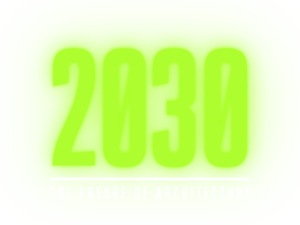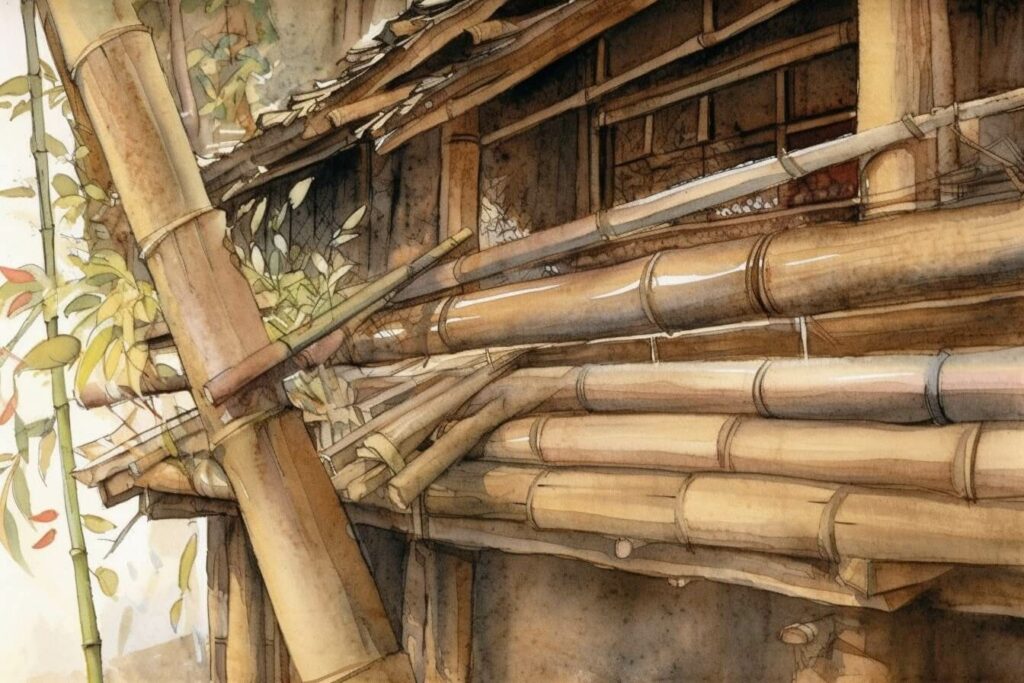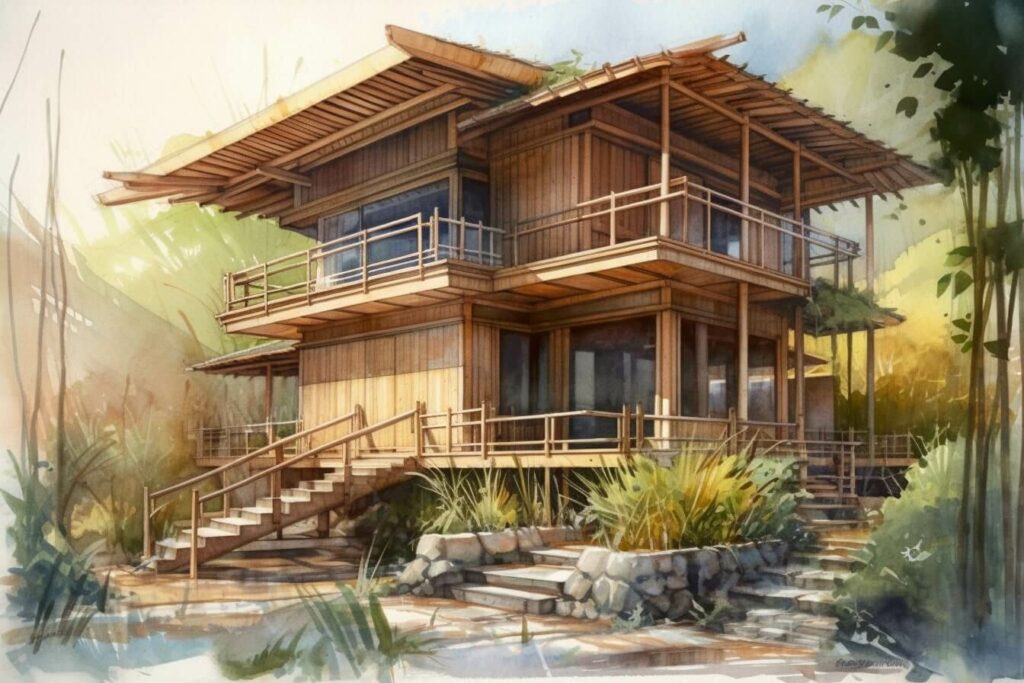
A FREE COURSE TO THE FOREFRONT OF ARCHITECTURE INNOVATION
A FUSION OF SUSTAINABLE DESIGN, HIGH-PERFORMANCE BUILDINGS, AND ARTIFICIAL INTELLIGENCE
JULY 8TH TO 12TH, 2024
ONLINE AND FREE EVENT
JULY 8TH TO 12TH, 2024
ONLINE AND FREE EVENT
By clicking the button, you agree to our Terms of Use and Privacy Policy, including the use of cookies and the sending of communications.
As the world becomes increasingly aware of the need for sustainable living, architects and interior designers are exploring innovative, eco-friendly building materials. Bamboo, a fast-growing and versatile plant, has emerged as a promising solution in the construction industry.
This comprehensive guide to the bamboo building will provide architects and interior designers with valuable insights into the world of bamboo construction, addressing the most frequently asked questions and exploring its remarkable potential.
Table of Contents for Bamboo Building:
- What makes bamboo an ideal building material?
- What types of bamboo are best for construction?
- How is bamboo treated and processed for building purposes?
- What are the various techniques used in bamboo construction?
- How does bamboo perform in terms of strength, flexibility, and durability?
- Can bamboo buildings withstand extreme weather conditions?
- What are the advantages and challenges of using bamboo in construction?
- What are some inspiring examples of bamboo architecture and interior design?
- How can architects and interior designers embrace bamboo in their practice?
- Conclusion: Discover the future of sustainable building with UGREEN
- What makes bamboo an ideal building material?
Why Develop a Bamboo Building?
Bamboo is an excellent building material for several reasons. Its rapid growth rate, reaching maturity in 3-5 years, makes it an abundant and renewable resource. In addition, bamboo is a low-cost material widely available in many regions, particularly in Asia and South America.
The carbon sequestration properties of bamboo also contribute to its sustainability, reducing the overall carbon footprint of construction projects.
Furthermore, its unique strength and flexibility make it an attractive alternative to conventional materials like concrete, steel, and wood.



What types of bamboo are best for a bamboo building?
With over 1,000 species of bamboo, selecting the most appropriate one for construction is crucial.
Moso (Phyllostachys edulis), Guadua (Guadua Angustifolia), and Madake (Phyllostachys bambusoides) are among the most popular species for building purposes due to their size, strength, and straightness.
These species can be found across Asia, Africa, and South America, allowing for a more localized and sustainable supply chain.
How is bamboo treated and processed to be used in a bamboo building?
Proper treatment and processing are essential for maximizing the performance and longevity of bamboo in construction. Harvesting should occur when bamboo reaches maturity, typically between 3-5 years. It is then treated to prevent insect infestation, decay, and shrinkage.
Standard treatment methods include boron-based solutions, pressure treatment, and smoke treatment.
After treatment, bamboo can be further processed into various forms, such as poles, panels, and flooring, depending on the intended application.
What are the various techniques used in a bamboo building?
Bamboo construction techniques vary widely depending on the project’s scale, design, and location. Some standard methods include:
- Bamboo frame construction: Similar to traditional timber framing, bamboo poles are used as vertical and horizontal structural elements connected with joinery or metal fasteners.
- Bamboo truss systems: Employing triangulated structures for added stability and strength, these systems can be used for roofing or as load-bearing elements in larger structures.
- Bamboo space frames: This technique connects multiple bamboo poles to create three-dimensional lattice structures, often used in large-span roofs or canopies.
- Bamboo reinforcement: Replacing steel rebar, bamboo can reinforce concrete structures, providing additional tensile strength and reducing environmental impact.


How does bamboo perform in terms of strength, flexibility, and durability when creating a bamboo building?
Bamboo boasts impressive mechanical properties, often surpassing those of conventional materials like wood and steel. Its tensile strength rivals that of steel, while its compressive strength exceeds that of concrete.
Bamboo’s exceptional flexibility allows it to bend without breaking, making it an ideal choice for earthquake-prone regions or structures that require elasticity.
Durability, however, depends on proper treatment, maintenance, and design. If adequately treated and protected from moisture and insects, bamboo can last for decades, with some structures known to survive over a century.
Integrating bamboo with other materials and incorporating thoughtful design can enhance its longevity.
Can bamboo buildings withstand extreme weather conditions?
Bamboo structures can withstand extreme weather conditions, including earthquakes, hurricanes, and heavy snowfall.
Bamboo’s inherent flexibility enables it to absorb and distribute forces, reducing the risk of collapse during seismic events. Its lightweight nature makes it less susceptible to damage from strong winds, while its impressive load-bearing capacity supports significant snow loads.
However, it’s essential to consider the local climate and employ appropriate design, construction techniques, and maintenance practices to ensure the structure’s long-term resilience.
What are the advantages and challenges of using bamboo in construction?
Advantages of Developing Bamboo Buildings:
- Sustainability: Bamboo’s rapid growth rate, renewability, and carbon sequestration capabilities make it an environmentally friendly building material.
- Strength and flexibility: Its impressive mechanical properties allow for innovative, resilient designs.
- Affordability: Bamboo is often more cost effective than traditional wood, steel, and concrete materials.
- Local availability: The wide distribution of bamboo species can reduce transportation costs and support local economies.
Challenges of Developing Bamboo Buildings:
- Durability concerns: Proper treatment and maintenance are crucial to prevent decay, insect infestation, and premature failure.
- Limited standardization: The construction industry lacks standardized guidelines and regulations for bamboo, which can create challenges in obtaining permits and insurance.
- Skill development: There is a need for increased training and education to equip professionals with the knowledge and skills to design and construct bamboo structures effectively.
What are some inspiring examples of bamboo architecture and interior design?
- The Green School, Bali: This eco-friendly campus incorporates bamboo in its classrooms, bridges, and multi-purpose halls, showcasing the potential of bamboo in large-scale construction.
- The Wind and Water Bar, Vietnam: An elegant bamboo dome structure demonstrates the material’s capacity for creating intricate, organic forms.
- Bamboo Wing, Vietnam: This striking, bird-like structure serves as a cultural space and exemplifies bamboo’s flexibility and strength.
How can architects and interior designers embrace bamboo in their practice?
Professionals can incorporate bamboo in their projects by:
- Educating themselves on bamboo’s properties, treatment, and construction techniques.
- Collaborating with bamboo suppliers and specialists to ensure proper sourcing, treatment, and application.
- Experimenting with bamboo as a primary or complementary material, considering its unique properties and aesthetics.
- Advocating for the development of standardized guidelines and regulations for bamboo construction.



Bamboo Building: A Conclusion
The bamboo building presents an exciting opportunity for architects and interior designers to create innovative, sustainable, resilient spaces. By understanding the potential of bamboo, professionals can help shape the future of sustainable architecture and design.
At UGREEN, we are committed to promoting sustainable living and building practices. Our sustainability consultancy services can guide you in integrating bamboo and other eco-friendly materials into your projects. Additionally, UGREEN Skills, our sustainability educational platform, offers courses and resources for professionals and companies to stay up-to-date on the latest trends in green building.
Let’s create a greener, more sustainable future through bamboo building and beyond. Explore UGREEN’s sustainability consultancy services and join the UGREEN Skills community today.



A FREE COURSE TO THE FOREFRONT OF ARCHITECTURE INNOVATION
A FUSION OF SUSTAINABLE DESIGN, HIGH-PERFORMANCE BUILDINGS, AND ARTIFICIAL INTELLIGENCE
JULY 8TH TO 12TH, 2024
ONLINE AND FREE EVENT
JULY 8TH TO 12TH, 2024
ONLINE AND FREE EVENT
By clicking the button, you agree to our Terms of Use and Privacy Policy, including the use of cookies and the sending of communications.
If you need our services in the Portuguese language, click here.
